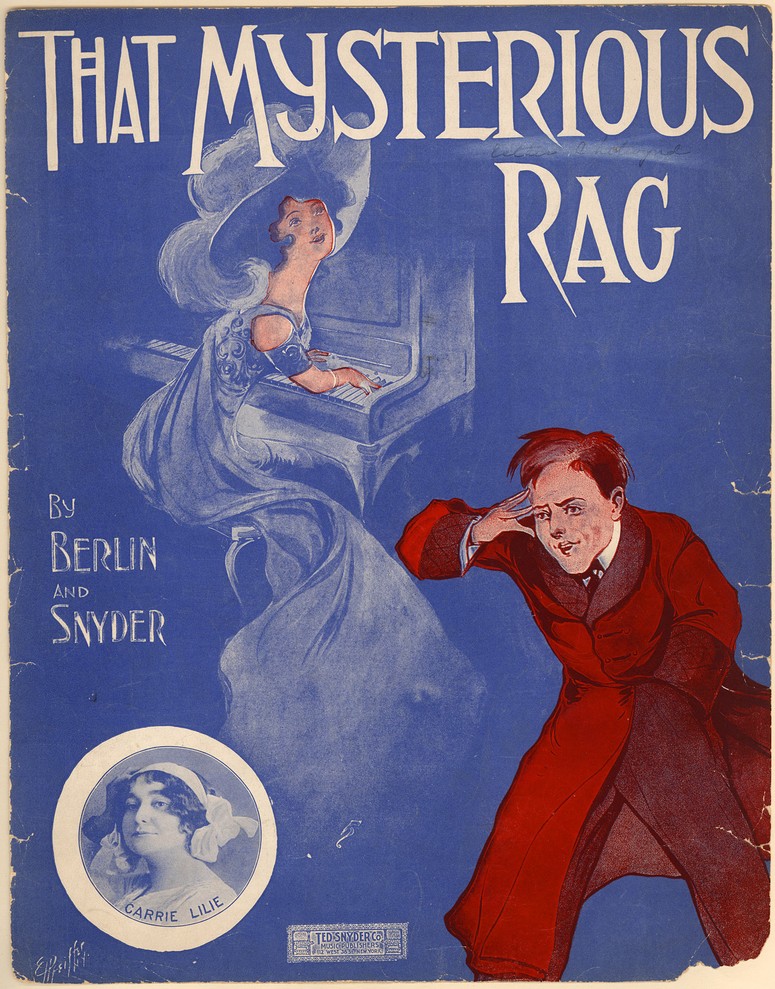That Mysterious Rag on:
[Wikipedia]
[Google]
[Amazon]
 "That Mysterious Rag" is a song by
"That Mysterious Rag" is a song by
 "That Mysterious Rag" is a song by
"That Mysterious Rag" is a song by Irving Berlin
Irving Berlin (born Israel Beilin; yi, ישראל ביילין; May 11, 1888 – September 22, 1989) was a Russian-American composer, songwriter and lyricist. His music forms a large part of the Great American Songbook.
Born in Imperial Russ ...
and Ted Snyder
Theodore Frank Snyder (August 15, 1881 in Freeport, Illinois – July 16, 1965 in Woodland Hills, California), was an American composer, lyricist, and music publisher. His hits include " The Sheik of Araby" (1921) and " Who's Sorry Now?" (1923). ...
written in 1911. It was one of the earliest Berlin songs to become a commercial success with recordings by Arthur Collins & Albert Campbell and by the American Quartet being very popular in 1912.
Composition
According to Howard Pollack in a biography ofGeorge Gershwin
George Gershwin (; born Jacob Gershwine; September 26, 1898 – July 11, 1937) was an American composer and pianist whose compositions spanned popular, jazz and classical genres. Among his best-known works are the orchestral compositions ' ...
, "That Mysterious Rag" was one of a trio of songs written by Berlin in 1911 that revolutionized American popular music, the others being "Alexander's Ragtime Band
"Alexander's Ragtime Band" is a Tin Pan Alley song by American composer Irving Berlin released in 1911 and is often inaccurately cited as his first global hit. Despite its title, the song is a march as opposed to a rag and contains little sync ...
" and "Everybody's Doin' It". Until the publication of this song ragtime
Ragtime, also spelled rag-time or rag time, is a musical style that flourished from the 1890s to 1910s. Its cardinal trait is its syncopated or "ragged" rhythm. Ragtime was popularized during the early 20th century by composers such as Scott J ...
had been so distinctively an African-American
African Americans (also referred to as Black Americans and Afro-Americans) are an ethnic group consisting of Americans with partial or total ancestry from sub-Saharan Africa. The term "African American" generally denotes descendants of ensl ...
musical genre that the occasional rag whose lyrics and cover art indicated some other ethnicity would focus instead on some other marginalized group (usually Jewish or Italian) and apply the dichotomy toward comic effect. With "That Mysterious Rag", notes Irving Berlin biographer Charles Hamm, ragtime music first sees cover art of a fashionably dressed white couple and lyrics that lack distinctive ethnic markers in dialect or syntax.
:Did you hear it? Were you near it? :If you weren't then you've yet to fear it; :Once you've met it you'll regret it, :Just because you never will forget it.The American Quartet recorded the piece in a generic accent. The musical structure also avoids characteristic ethnic overtones. As Hamm explains:
There is no trace of syncopation beyond a single 3+3+2 pattern in the chorus, no minor tonality, no reference to one ethnic group or another. The most arresting moment, the cross-relation at the beginning of the verse, has no specific ethnic (or any other) connotation."That Mysterious Rag" is the first instance of a change that Berlin employs consistently from 1912 onward: a generic style lacking in specific ethnic connotations whose audience is no longer solely the working class, but whose reach includes patrons of the
legitimate theater
Legitimate theatre is live performance that relies almost entirely on diegetic elements, with actors performing through speech and natural movement.Joyce M. Hawkins and Robert Allen, eds. "Legitimate" entry. ''The Oxford Encyclopedic English Dict ...
. Berlin continued to use ''rag'' and ''ragtime'' in song titles during the period when the terms were nearly synonymous with popular music. Although Berlin's compositions differed significantly from classic piano rags by Scott Joplin and other African-American composers, Hamm contends that Berlin's work targeted a different audience and the commercial success of Berlin songs such as "That Mysterious Rag" neither helped nor hindered the sales of piano rags. Or as Richard Crawford explains, ''"That Mysterious Rag" recognizes the style's haunting, distracting traits and removes it from a racial setting.'' Crawford finds other faults with the lyrical structure: ''It would be hard to find another Berlin song with one-syllable words so awkwardly stretched or natural declamation so bent out of shape.''
Performance and reception
Berlin performed the piece during September 1911 wearing a coat and tails, receiving star billing at the Hammerstein Victoria Theatre owned byWillie Hammerstein
William Hammerstein (September 26, 1875 – June 10, 1914) was an American theater manager. He ran the Victoria Theatre on what became Times Square, Manhattan, presenting very popular vaudeville shows with a wide variety of acts. He was known fo ...
at Times Square
Times Square is a major commercial intersection, tourist destination, entertainment hub, and neighborhood in Midtown Manhattan, New York City. It is formed by the junction of Broadway, Seventh Avenue, and 42nd Street. Together with adjacent ...
. Berlin refused calls for encores and received a favorable review from ''Variety
Variety may refer to:
Arts and entertainment Entertainment formats
* Variety (radio)
* Variety show, in theater and television
Films
* ''Variety'' (1925 film), a German silent film directed by Ewald Andre Dupont
* ''Variety'' (1935 film), ...
''. Erik Satie used "That Mysterious Rag" in 1917 for his ballet '' Parade''. The song remained popular for more than a decade.
References
{{Authority control Songs written by Irving Berlin 1911 songs Songs with music by Ted Snyder